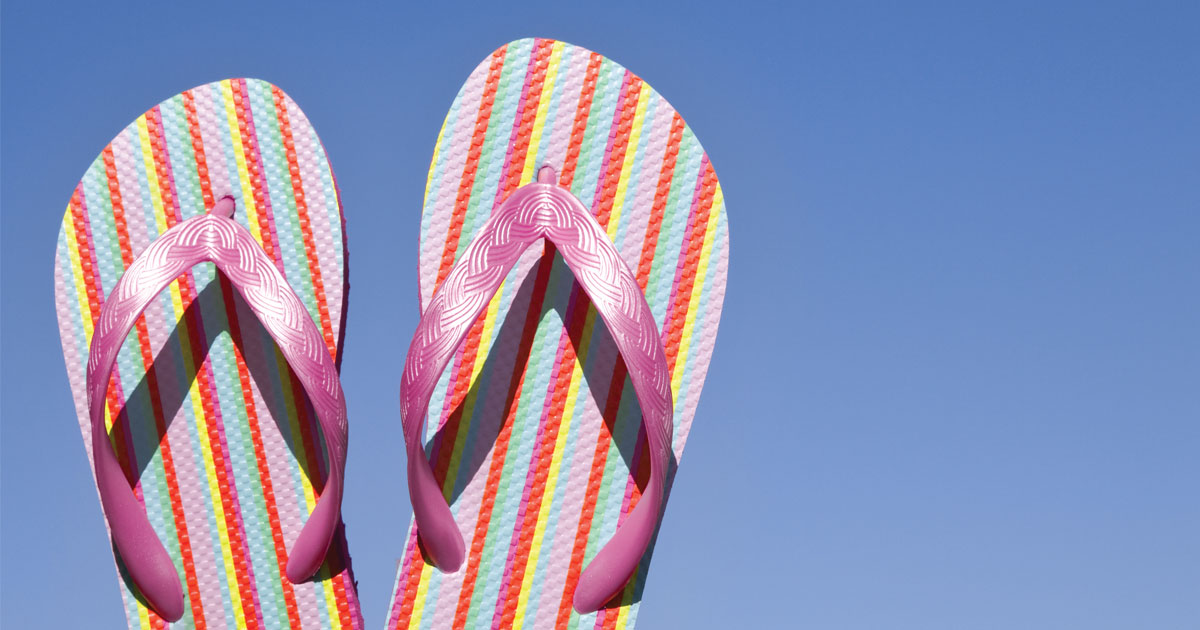Flip flops first appeared in the U.S. after World War II when soldiers brought this novelty footwear home from Japan. Since that humble debut, flip flops have become the warm weather footwear favorite that now practically symbolizes summer. Flip flops are casual and fun, but fashionable, too, available in every imaginable color and style, graced with flowers, bows, college logos, and innumerable other adornments. When the mercury rises, flip flops keep your feet cool and let you show off your pedi. What’s not to love?
While the fun and fashion aspects of flip flops are indisputable, there are a few drawbacks you should know about. In terms of foot health and protection, flip flops are a good news/bad news scenario.
First, the good news. Whether you are walking or just standing around chatting with friends, flip flops are always better than going barefoot. They provide basic protection for your feet when you’re on any hot or rough surface, such as a sidewalk or the concrete around a swimming pool. Wearing flip flops also protects you from the fungus that causes athlete’s foot, an infection you can catch simply by coming in contact with skin flakes on the floor of a public shower or gym. Similarly, flip flops can spare your feet from plantar warts, which are also contagious, transmitted when the plantar surface of your foot (the sole) comes in contact with the offending virus. The germ barrier created by flip flops is especially important if you happen to be diabetic and have a cut or sore on the bottom of your feet.
Here’s the downside to flip flops, which is much more significant. While flip flops can spare you from an encounter with a fungus or virus, they don’t provide much protection from injury. Flip flops leave you vulnerable to stubbed toes, puncture wounds, torn toenails, and anything accidentally dropped on your foot. In addition, flip flops provide no arch support, no heel cushioning, and no shock absorption, according to the American Podiatric Medical Association (APMA). That’s why it’s important to know when notto wear flip flops.
Experts say that flip flops are never the right footwear choice when you will be:
- Doing a lot of walking¾a day of shopping or visiting a zoo or amusement park, for example.
- Running or playing sports. Flip flops are a poor substitute for athletic shoes. Wearing flip flops even for an impromptu game of Frisbee can land you in the emergency room with a sprain or a fracture.
- Mowing or doing yardwork. Flip flops are no match for mowers, string trimmers, or the critters that hang out in yards and fields—bugs and snakes. Close contact with Mother Nature always calls for closed-toed shoes.
- This is a safety issue. If one of your flip flops comes off or gets stuck under the gas or brake pedal, you might be risking a fender bender or worse.
We all love flip flops for their convenience. Flip flops are so easy to slip on to run a quick errand, walk a few feet to the mailbox, or join some friends for lunch. But if you wear flip flops when you shouldn’t, that is, when something more supportive or protective is called for, as in the bullet points above, your feet may repay you with arch pain, tendonitis, heel pain, or even a sprained ankle.
If you want to avoid foot problems, but you don’t want to trade the breezy summer feel of flip flops for shoes, the APMA suggests a compromise: supportive sandals such as those made by Dansko, Rockport, or Wolky. If those options don’t appeal to you, consider Crocs, which at least protect your toes.
Flip flops are wildly popular, in part, because they are so inexpensive. The cheapest flip flops, unfortunately, are made from the materials you should avoid: plastic and rubber. The decision to spend a little more on flip flops can mean better protection for your feet. The best flip flops are those made of soft leather, which helps protect your feet from blisters and irritations. Better flip flops often also provide some arch support, which can be a big plus if you wear them a lot. Before you buy a pair of flip flops, give them the bend test: if you can easily bend flip flops completely in half, they are too flimsy. Some bending at the ball of the foot is okay; you need that flexibility to walk.
A final pearl of wisdom from foot care professionals is to keep in mind that flip flops wear out over time. Before you slip on last summer’s flip flops, inspect them for wear and tear. If they are looking worn, throw them out and get new ones. (Your feet will thank you!)






















